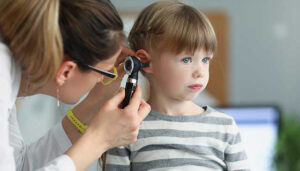What Is Otitis Media?
Otitis media refers to an inflammation or infection of the middle ear, typically causing symptoms such as earache, reduced hearing, and occasionally, fever. A common complication is middle ear effusion, which occurs when fluid builds up behind the eardrum — often without infection — causing discomfort or temporary hearing loss.
This condition can affect individuals of all ages but is particularly common in children. Knowing the various forms of otitis media and how they’re treated can make it easier to manage symptoms and avoid serious complications.
Types of Otitis Media
Otitis media typically occurs in three main forms:
- Acute Otitis Media

Acute otitis media is a quick-onset infection of the middle ear, most often triggered by bacteria or viruses. It typically brings on symptoms like intense ear pain, fever, and increased irritability. In children, this may also lead to disturbed sleep, tugging at the ear, or crying.
Acute otitis media in pediatrics is especially prevalent because children have smaller and more horizontal Eustachian tubes, which makes it easier for bacteria or viruses to get trapped and cause an infection.
- Otitis Media with Effusion (Middle Ear Effusion)
This type involves fluid buildup in the middle ear but occurs without the typical signs of an active infection. It may occur after an episode of acute otitis media or develop independently due to poor Eustachian tube function.
Middle ear effusion can lead to muffled hearing and a feeling of fullness in the ear. Although it’s not always painful, untreated cases can affect speech and learning in children if they experience frequent or prolonged episodes.
- Chronic Otitis Media
When otitis media persists for several weeks or recurs frequently, it is classified as chronic. This can involve continuous or repeated ear discharge through a perforated eardrum, and in some cases, permanent hearing loss. Chronic otitis media should be addressed quickly by a medical professional to avoid lasting damage to the ear.
Causes and Risk Factors
Otitis media is often triggered by:
- Colds, sinus infections, and other upper respiratory illnesses
- Allergic reactions that trigger swelling and lead to fluid accumulation
- Poor Eustachian tube function
- Exposure to tobacco smoke
- Bottle feeding while lying down in infants
Children in daycare settings or those with a family history of ear infections are also at higher risk.
Common Symptoms
- Ear pain or discomfort
- Fullness or pressure in the ear
- Muffled or reduced hearing
- Drainage of fluid (in chronic cases)
- Restlessness and difficulty sleeping, particularly in young children
- Fever (mainly in acute otitis media)
In acute otitis media in pediatrics, these symptoms may come on suddenly and resolve with proper care.
Otitis Media Treatment
- Observation & Monitoring
For mild cases, especially of middle ear effusion, doctors may recommend a “watchful waiting” approach for a few days, as symptoms can sometimes resolve on their own.
- Antibiotics
Bacterial infections often require antibiotics like amoxicillin, particularly in children under 2 years old or those with severe symptoms.
- Pain Management
Non-prescription medicines like acetaminophen or ibuprofen can ease ear discomfort and reduce fever.
- Surgery (Myringotomy/Tympanostomy)
For recurrent infections or persistent fluid buildup, especially affecting hearing or speech development, small tubes may be surgically placed in the eardrum to drain fluid and ventilate the middle ear.
This is a common otitis media treatment in children with chronic middle ear effusion.
When to See a Doctor
Consult a doctor if:
- Symptoms last more than 2–3 days
- Discharge of fluid or pus coming from the ear
- Hearing problems persist
- A child is younger than 6 months and showing symptoms
- You notice signs of chronic otitis media
Preventing Middle Ear Effusion and Infections
- Keep children away from secondhand smoke
- Practice good hand hygiene
- Encourage breastfeeding in infants
- Ensure timely vaccinations (flu, pneumococcal vaccines)
- Avoid feeding babies while lying flat
Final Thoughts
Middle ear effusion and other forms of otitis media are common, especially in children, but they don’t have to result in long-term problems if identified and treated early. From home care to medical intervention, the right steps can bring relief and preserve hearing health.
Understanding the difference between acute otitis media, chronic otitis media, and effusion without infection helps in seeking the right otitis media treatment before complications arise.


